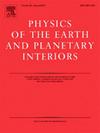从现场声速测量推断的火星地幔地震结构
IF 1.9
3区 地球科学
Q2 GEOCHEMISTRY & GEOPHYSICS
引用次数: 0
摘要
我们报告了通过超声干涉测量、同步辐射技术和多砧装置实验相结合的方法测量富铁软锰矿聚集体的弹性波速(Vp:纵波速度和Vs: s波速度)。我们对两种不同的大块软锰矿组成进行了8次同步加速器原位实验,Fe/(Fe + Mg)比(Fe#)分别为0.17和0.27,压力范围为3至16 GPa,温度范围为1000°C。这些数据由7个实验室非原位实验补充,温度范围为5至16 GPa,温度范围为900°C至1300°C,使用相同的起始成分。基于这些结果和以前的软锰矿成分数据,我们模拟了铁对沿着几个可能的火星热区地震剖面的影响。如果像以前的研究报道的那样,火星地幔的铁含量很高,例如铁含量= 0.27,那么它将由四个由三个地震不连续面分开的层组成。它们将位于~ 620公里的深度(ΔVp + 8.25%;ΔVs + 6.72%), ~ 880公里(ΔVp + 2.35%;ΔVs = 0.03%)和~ 1130 km (ΔVp = - 17.88%;ΔVs = - 13.05%)。然而,由于洞察号的地震数据在深度小于1000公里的地方没有推断出主要的不连续,我们得出的结论是,火星地幔的Fe#明显低于0.20。对于fe# 0.17组成,我们的实验显示单一不连续(ΔVp + 5.62%;ΔVs = + 10.44%),这是由橄榄石向瓦兹利石的转变引起的,深度为~ 980 km,与地震资料相符。现有的火星地球化学和地球物理数据表明,火星内部富含铁,但仅凭这些信息还不足以限定火星地幔的矿物学和内部结构。在本研究中,我们通过实验确定了两种不同富铁地幔成分的弹性波速(Vp:纵波速度和Vs:横波速度),其中Fe#比(=Fe/(Mg + Fe))分别为0.17和0.27,在覆盖火星地幔条件的压力和温度范围内。然后,我们计算了最近在文献中提出的不同热剖面在火星内部预期的地震波速度剖面。有三个相互补充的论点支持相对较低的火星地幔Fe#:(i)在600公里深度附近缺乏地震不连续表明没有向环伍德岩的相变,因此Fe#明显低于~ 0.27。(ii)一个地震不连续面同时影响Vp和Vs的报道仅与橄榄石到瓦德斯莱石的转变相容,据报道,这种转变发生在Fe#低于0.2时。(iii)在1000 km(即~ 13 GPa)处报道的地震转变与我们的测量结果一致,Fe#为0.17(±0.02)。本文章由计算机程序翻译,如有差异,请以英文原文为准。

Seismic structure of Martian mantle inferred from in situ sound velocity measurements
We report elastic wave velocity (Vp: P-Waves velocity, and Vs: S-wave velocities) measurements of iron-enriched pyrolite aggregates by a combination of ultrasonic interferometry, synchrotron radiation techniques and multi-anvil apparatus experiments. We carried out eight synchrotrons in situ experiments on two different bulk pyrolite compositions with Fe/(Fe + Mg) ratio (Fe#) of 0.17 and 0.27, over a range of pressures from 3 to 16 GPa and temperatures up to 1000 °C. These data are complemented by seven laboratory ex situ experiments between 5 and 16 GPa and temperatures varying from 900 °C to 1300 °C, using the same starting compositions. Based on these results and previous data on pyrolite composition, we modeled the effect of iron on seismic profiles along several possible Martian areotherms.
If, as reported in previous works, the Martian mantle had a very high Fe#, for instance Fe# = 0.27, it would be composed of four layers separated by three seismic discontinuities. They would be located at depths of ∼620 km (ΔVp of +8.25 %; ΔVs of +6.72 %), ∼880 km (ΔVp of +2.35 %; ΔVs of 0.03 %) and ∼ 1130 km (ΔVp of −17.88 %; ΔVs of −13.05 %). However, since there is no major discontinuity inferred by InSight's seismic data at depths shallower than 1000 km, we conclude that the Martian mantle presents a Fe# significantly lower than 0.20. For the Fe#0.17 composition, our experiments show a single discontinuity (ΔVp of +5.62 %; ΔVs of +10.44 %) induced by the transition from olivine to wadsleyite at ∼980 km depth, which is compatible with the seismic data.
Plain language summary
The geochemical and geophysical data available for Mars suggest an interior enriched in iron, but this information alone is insufficient to constrain the mineralogy and the internal structure of the Martian mantle. In this study, we determine experimentally the elastic wave velocities (Vp: P-Waves velocity, and Vs: S-wave velocities) of two different iron-rich mantle compositions, with Fe# ratios (=Fe/(Mg + Fe)) of 0.17 and 0.27, in a range of pressure and temperature covering the Martian mantle conditions. We then calculate the seismic wave velocity profiles expected in the Mars interior for the different thermal profiles recently proposed in the literature. Three complementary arguments arise in favor of a relatively low Fe# of the Martian mantle: (i) the lack of seismic discontinuity at around 600 km depth suggests the absence of a phase transition to ringwoodite and therefore Fe# significantly lower than ∼0.27. (ii) The report of one seismic discontinuity affecting both Vp and Vs is only compatible with the olivine to wadsleyite transition, which was reported to occur for Fe# lower than 0.2. (iii) A seismic transition reported at 1000 km (i.e. ∼13 GPa) is compatible with our measurements with Fe# of 0.17 (± 0.02).
求助全文
通过发布文献求助,成功后即可免费获取论文全文。
去求助
来源期刊

Physics of the Earth and Planetary Interiors
地学天文-地球化学与地球物理
CiteScore
5.00
自引率
4.30%
发文量
78
审稿时长
18.5 weeks
期刊介绍:
Launched in 1968 to fill the need for an international journal in the field of planetary physics, geodesy and geophysics, Physics of the Earth and Planetary Interiors has now grown to become important reading matter for all geophysicists. It is the only journal to be entirely devoted to the physical and chemical processes of planetary interiors.
Original research papers, review articles, short communications and book reviews are all published on a regular basis; and from time to time special issues of the journal are devoted to the publication of the proceedings of symposia and congresses which the editors feel will be of particular interest to the reader.
 求助内容:
求助内容: 应助结果提醒方式:
应助结果提醒方式:


